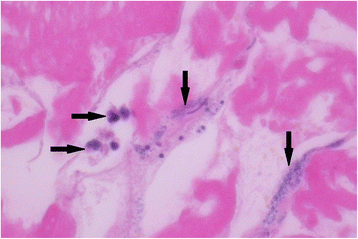Zoonotic necrotizing myositis caused by Streptococcus equi subsp. zooepidemicus in a farmer
- PMID: 28201995
- PMCID: PMC5312586
- DOI: 10.1186/s12879-017-2262-7
Zoonotic necrotizing myositis caused by Streptococcus equi subsp. zooepidemicus in a farmer
Abstract
Background: Streptococcus equi subsp. zooepidemicus is a beta-hemolytic group C streptococcus mainly causing infections in domesticated animals. Here we describe the first case of zoonotic necrotizing myositis caused by this bacterium.
Case presentation: The patient was a 73-year-old, previously healthy farmer with two asymptomatic Shetland ponies in his stable. After close contact with the ponies while feeding them, he rapidly developed erythema of his left thigh and sepsis with multiple organ failure. The clinical course was severe and complicated, requiring repetitive surgical excision of necrotic muscle, treatment with vasopressors, mechanical ventilation and continuous venovenous hemofiltration, along with adjunctive hyperbaric oxygen therapy. The patient was discharged from hospital at day 30, without obvious sequelae. The streptococcal isolate was identified as Streptococcus equi by MALDI-ToF MS, and was later assigned subspecies identification as S. equi subsp. zooepidemicus. Multilocus sequence typing identified the strain as a novel sequence type (ST 364), closely related to types previously identified in horses and cattle. A focused proteomic analysis revealed that the ST 364 expressed putative virulence factors similar to that of Streptococcus pyogenes, including homologues of the M protein, streptodornases, interleukin 8-protease and proteins involved in the biosynthesis of streptolysin S.
Conclusion: This case illustrates the zoonotic potential of S. equi subsp. zooepidemicus and the importance of early clinical recognition, rapid and radical surgical therapy, appropriate antibiotics and adequate supportive measures when necrotizing soft tissue infection is suspected. The expression of Streptococcus pyogenes-like putative virulence determinants in ST 364 might partially explain the fulminant clinical picture.
Keywords: Case report; Necrotizing myositis; Streptococcus equi subsp. zooepidemicus; Zoonosis.
Figures
Similar articles
-
Transmission of Streptococcus equi subspecies zooepidemicus infection from horses to humans.Emerg Infect Dis. 2013 Jul;19(7):1041-8. doi: 10.3201/eid1907.121365. Emerg Infect Dis. 2013. PMID: 23777752 Free PMC article.
-
Outbreak of upper respiratory disease in horses caused by Streptococcus equi subsp. zooepidemicus ST-24.Vet Microbiol. 2013 Sep 27;166(1-2):281-5. doi: 10.1016/j.vetmic.2013.05.006. Epub 2013 May 25. Vet Microbiol. 2013. PMID: 23773239
-
Dissemination of the superantigen encoding genes seeL, seeM, szeL and szeM in Streptococcus equi subsp. equi and Streptococcus equi subsp. zooepidemicus.Vet Microbiol. 2005 Aug 10;109(1-2):135-41. doi: 10.1016/j.vetmic.2005.05.001. Vet Microbiol. 2005. PMID: 15953700
-
The pathogenic equine streptococci.Vet Res. 2004 Jul-Aug;35(4):397-409. doi: 10.1051/vetres:2004025. Vet Res. 2004. PMID: 15236673 Review.
-
Streptococcus equi subspecies zooepidemicus meningitis--a case report and review of the literature.Eur J Clin Microbiol Infect Dis. 2010 Dec;29(12):1459-63. doi: 10.1007/s10096-010-1037-5. Epub 2010 Sep 5. Eur J Clin Microbiol Infect Dis. 2010. PMID: 20820836 Review.
Cited by
-
Streptococcus equi subsp. zooepidemicus Supernatant Containing Streptolysin S Alters the Equine Nasal and Vaginal Mucosa, Modulating Equine Herpesvirus 1, 3 and 4 Infections.Viruses. 2025 Jul 14;17(7):980. doi: 10.3390/v17070980. Viruses. 2025. PMID: 40733597 Free PMC article.
-
Prospective bacterial and fungal sources of hyaluronic acid: A review.Comput Struct Biotechnol J. 2022 Nov 10;20:6214-6236. doi: 10.1016/j.csbj.2022.11.013. eCollection 2022. Comput Struct Biotechnol J. 2022. PMID: 36420162 Free PMC article. Review.
-
Characterization of Streptococcus equi subsp. zooepidemicus isolates containing lnuB gene responsible for the L phenotype.PLoS One. 2023 Apr 28;18(4):e0284869. doi: 10.1371/journal.pone.0284869. eCollection 2023. PLoS One. 2023. PMID: 37115801 Free PMC article.
-
Antimicrobial resistance among Streptococcus equi subspecies zooepidemicus and Rhodococcus equi isolated from equine specimens submitted to a diagnostic laboratory in Kentucky, USA.PeerJ. 2022 Sep 21;10:e13682. doi: 10.7717/peerj.13682. eCollection 2022. PeerJ. 2022. PMID: 36164606 Free PMC article.
-
Isolation and characterization of bacteriophages specific to Streptococcus equi subspecies zooepidemicus and evaluation of efficacy ex vivo.Front Microbiol. 2024 Oct 28;15:1448958. doi: 10.3389/fmicb.2024.1448958. eCollection 2024. Front Microbiol. 2024. PMID: 39529671 Free PMC article.
References
-
- McClure SR, Koenig R, Hawkins PA. A randomized controlled field trial of a novel trimethoprim-sulfadiazine oral suspension for treatment of Streptococcus equi subsp zooepidemicus infection of the lower respiratory tract in horses. J Am Vet Med Assoc. 2015;246(12):1345–53. doi: 10.2460/javma.246.12.1345. - DOI - PubMed
-
- Bordes-Benitez A, Sanchez-Onoro M, Suarez-Bordon P, Garcia-Rojas AJ, Saez-Nieto JA, Gonzalez-Garcia A, Alamo-Antunez I, Sanchez-Maroto A, Bolanos-Rivero M. Outbreak of Streptococcus equi subsp. zooepidemicus infections on the island of Gran Canaria associated with the consumption of inadequately pasteurized cheese. Eur J Clin Microbiol Infect Dis. 2006;25(4):242–6. doi: 10.1007/s10096-006-0119-x. - DOI - PubMed
Publication types
MeSH terms
Substances
LinkOut - more resources
Full Text Sources
Other Literature Sources
Medical
Miscellaneous


